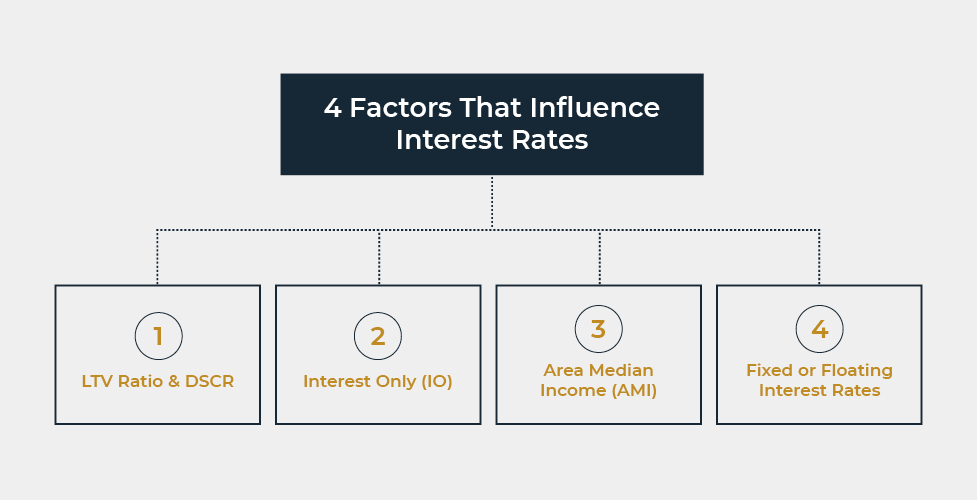Interest rates have been in the news lately, as the Federal Reserve has continued to inch them upward in an effort to fight inflation. But the central bank is not the only influence on interest rates; investors determine the interest rates of benchmark Treasury securities and floating rate indexes (like SOFR), and banks and other lenders determine the interest rate a borrower will pay when taking out a multifamily mortgage.
So how are interest rates underwritten and set by a lenderThe person or party (such as a bank or corporate entity) that loans money on a commercial real estat..., and why do they vary from loan to loan? One important factor for underwriters when they calculate interest rates for a loan is risk. Generally speaking, the lower the risk, the lower the interest rate offered—although there are additional factors that contribute as well.
Some of the variables that can affect interest rates include

Loan-To-Value (LTV) RatioThe amount of money borrowed in relation to the total market value of a property, calculated by divi... and Debt Service Coverage Ratio (DSCR)The DSCR is a tool used to underwrite a loan secured by an income producing property. The ratio is c...
In general, a loan with a high LTV and/or a low DSCR will be seen as riskier. That’s because these scores suggest that it’s less likely that the asset would cover the debt service on the loan in case the performance of the collateral property declines, or that the lender might not realize sufficient proceeds from the sale of the property after a default to recover the outstanding balance and accrued interest of the loan. For these reasons, riskier loans typically will bear a higher interest rate.
Interest Only (IO)
Agency lenders can offer an IO period of 12 months or longer, during which only interest payments are collected, and loan principal does not amortize. This option will often result in a slightly higher interest rate depending on certain risk parameters, including the loan term, DSCR, LTV, and strength of the market. Investors choose the IO option for different reasons; in most cases to provide greater cash flow during the initial year or years of the loan.
Area Median Income (AMI)
Some properties qualify for affordable housing financing programs, which may lower costs based on whether units are considered affordable to households earning certain percentages of AMI. Qualification is determined using rent calculators provided by government agencies Fannie Mae and Freddie Mac. To determine the possible discounts, data such as exact rent amounts, property location, and unit mix (studio, 1-bedroom, 2-bedroom) are required. The agencies will determine available discounts using these data points.
Fixed or Floating Interest Rates
A fixed rate is an attractive option for investors who want to know with certainty what their monthly debt service payment will be. Loans with a floating rate can have different monthly loan payments based on movement of the underlying interest rate index. For agency floating rate loans, the frequency of rate changes is defined, as is the total rate movement that can occur at any one time (period caps) and the total rate change that can happen over the life of the loan (life-of-loan caps).
The above are just a few examples of factors that can influence a loan’s interest rate and total monthly payment amount. But these basic principles will always be taken under consideration when lenders underwrite a loan—no matter what the economic climate. Understanding them will give you an edge while you work with an originator to score the best possible interest rate for your loan.
A quote for your next multifamily investment is just seconds away. Simply type in the property address and let us do the rest!




